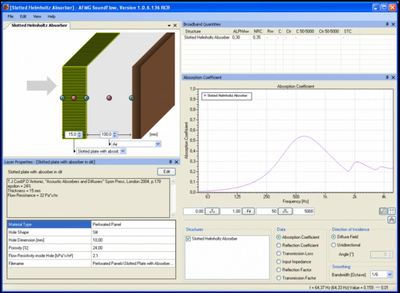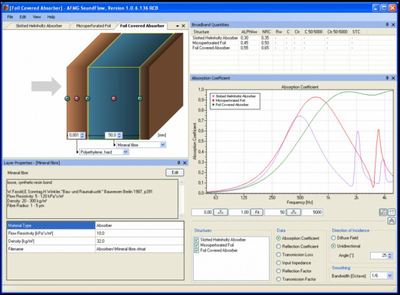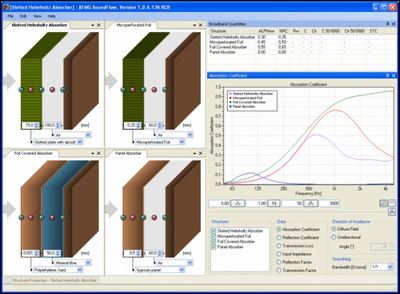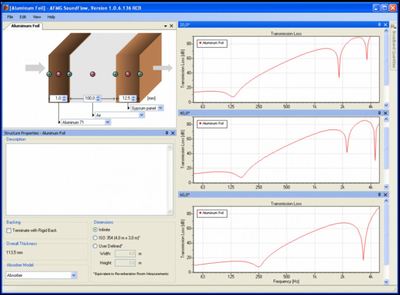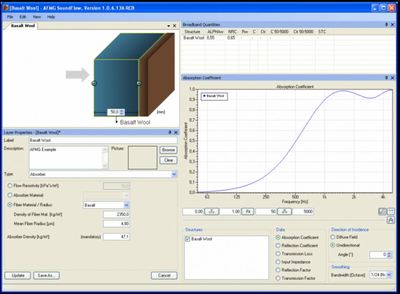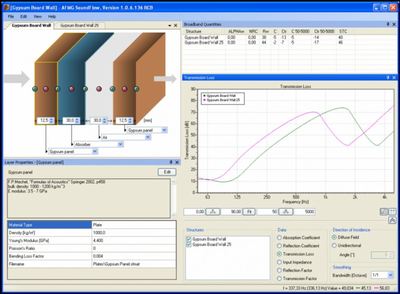AFMG SoundFlow - For the acoustic design of multi-layer structures
AFMG SoundFlow is a simulation software for calculating the absorption, reflection, and transmission of sound by multi-layer structures. The software enables the modeling of wall, floor and ceiling structures by specifying layer materials and thickness. Various calculation parameters can be defined and the graphic results display the frequency dependent absorption and reflection coefficients as well as the transmission loss, the complex input impedance and other acoustical measures.
The calculation engine of AFMG SoundFlow is an accurate implementation based on the theory of sound absorbers developed by Mechel, Bies and others. Various computational models are available including the calculation according to the ISO 12354 standard. All results can be exported as tables, graphics, complete reports and as EASE material files.
The calculation engine of AFMG SoundFlow is an accurate implementation based on the theory of sound absorbers developed by Mechel, Bies and others. Various computational models are available including the calculation according to the ISO 12354 standard. All results can be exported as tables, graphics, complete reports and as EASE material files.
SoundFlow is a simulation software for calculating the absorption, reflection, and transmission of sound by multi-layer structures. The software enables the modeling of wall, floor and ceiling structures by specifying layer materials and thickness. Various calculation parameters can be defined and the graphic results display the frequency dependent absorption and reflection coefficients as well as the transmission loss, the complex input impedance and other acoustical measures.
SoundFlow provides an intuitive graphic interface for defining the number of layers, their thickness and their material. A database with common materials enables quick modeling of multiple layers. The materials in the database are divided into three types: absorbers, perforated panels and plates. The classification depends on the basic acoustic characteristics of the material, e.g. the mechanisms of how it conducts and absorbs sound. For each type, different physical properties are used to define the material in the calculation. Absorbers, for example are specified by their flow resistivity. Perforated plates are characterized by their porosity, among others. One of the physical properties for describing plates is the coincidence frequency.
Materials can be modified or new materials can be created by entering their physical properties. Saving a new material will add it to the database. Modified and new structures can be saved and exported as an EASE Material File in order to use the absorption coefficient data in other simulation programs, such as EASE and EASE Evac.
SoundFlow allows the modification of several structures at the same time and the result window displays the acoustic characteristics of these structures also at the same time. The following calculation results are shown:
The axes of the graphs as well as the frequency resolution are adjustable. One can also define the direction of incidence, either by entering a particular angle or by assuming a diffuse field.
The calculation engine is an accurate implementation based on the theory of sound absorbers developed by Mechel, Bies and others. You can choose between various computational models including the calculation according to the ISO 12354 standard. However, note that the current software version does not support glued or laminated layers, metal studs and similar constructions or flanking effects. With respect to plates, the current software version is also limited to the theory of thin plates which allows considering structures with a thickness of up to 3 to 4 wavelengths in practice.
Note also, that the numerical models used in SoundFlow assume that surface elements are large compared to the wavelength of interest. Although SoundFlow accounts for some finite-size effects such as the increased effective surface area due to edge diffraction effects, the prediction accuracy for small surface elements will depend strongly on the properties of the material and the shape of the sample.
SoundFlow provides an intuitive graphic interface for defining the number of layers, their thickness and their material. A database with common materials enables quick modeling of multiple layers. The materials in the database are divided into three types: absorbers, perforated panels and plates. The classification depends on the basic acoustic characteristics of the material, e.g. the mechanisms of how it conducts and absorbs sound. For each type, different physical properties are used to define the material in the calculation. Absorbers, for example are specified by their flow resistivity. Perforated plates are characterized by their porosity, among others. One of the physical properties for describing plates is the coincidence frequency.
Materials can be modified or new materials can be created by entering their physical properties. Saving a new material will add it to the database. Modified and new structures can be saved and exported as an EASE Material File in order to use the absorption coefficient data in other simulation programs, such as EASE and EASE Evac.
SoundFlow allows the modification of several structures at the same time and the result window displays the acoustic characteristics of these structures also at the same time. The following calculation results are shown:
- Absorption coefficient
- Reflection coefficient
- Transmission loss
- Input impedance including the complex real and imaginary part as well as magnitude and phase
- Reflection factor including the complex real and imaginary part as well as magnitude and phase
- Transmission factor including the complex real and imaginary part as well as magnitude and phase
The axes of the graphs as well as the frequency resolution are adjustable. One can also define the direction of incidence, either by entering a particular angle or by assuming a diffuse field.
The calculation engine is an accurate implementation based on the theory of sound absorbers developed by Mechel, Bies and others. You can choose between various computational models including the calculation according to the ISO 12354 standard. However, note that the current software version does not support glued or laminated layers, metal studs and similar constructions or flanking effects. With respect to plates, the current software version is also limited to the theory of thin plates which allows considering structures with a thickness of up to 3 to 4 wavelengths in practice.
Note also, that the numerical models used in SoundFlow assume that surface elements are large compared to the wavelength of interest. Although SoundFlow accounts for some finite-size effects such as the increased effective surface area due to edge diffraction effects, the prediction accuracy for small surface elements will depend strongly on the properties of the material and the shape of the sample.
Feature Overview
The software supports the following features:
- Easy and quick entry of layers, by means of their thickness and their acoustic material.
- Expandable database of about 150 acoustic materials.
- Various common acoustic quantities such as ALPHAw, NRC, Rw and STC figures.
- Frequency response plots for absorption coefficient, reflection coefficient and transmission loss.
- Calculations at specific angle of incidence or for diffuse field.
- Data smoothing functions.
- Simultaneous examination of several structures.
- Display and overlay functions for comparison of results at different frequencies, different angles or of multiple structures.
- Result output to a editable and printable format, such as RTF, PDF and text, as well as to various bitmap formats, such as BMP and PNG.
- Absorption coefficients can be saved directly as EASE wall materials (MAT).
- Material types: absorbers, plates, perforated panels.
- Full support for US Customary units, such as fractional inch.
- Calculation and display of complex input impedance, complex reflection factor and complex transmission factor.
- Numerous absorber models: Mechel, Bies, Komatsu, ISO 12354, Miki, Delany-Bazley and more.
- Transmission calculations with open back or absorption calculations with rigid back termination.
- Maximum frequency range of 10 Hz to 20 kHz.
